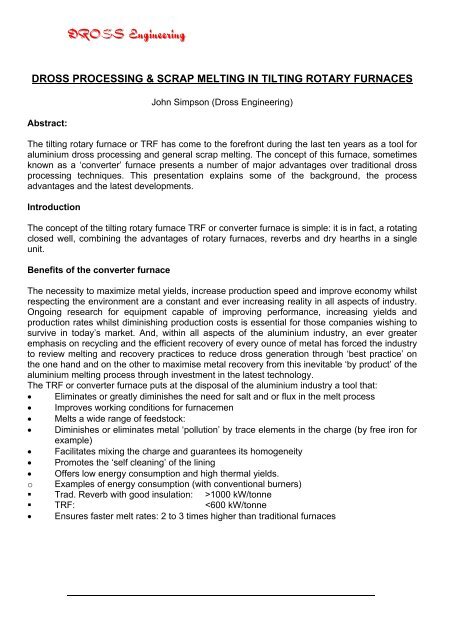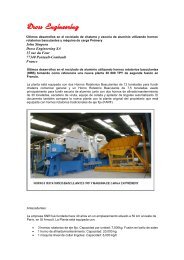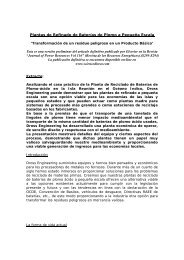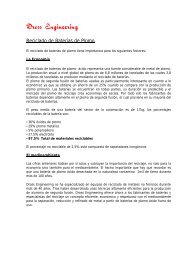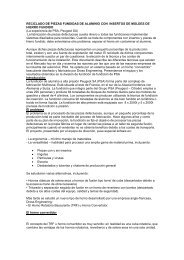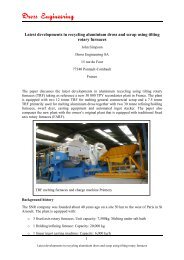developments in converter furnace technology - Dross engineering
developments in converter furnace technology - Dross engineering
developments in converter furnace technology - Dross engineering
Create successful ePaper yourself
Turn your PDF publications into a flip-book with our unique Google optimized e-Paper software.
DROSS S Eng<strong>in</strong>eeeerri<strong>in</strong>gDROSS PROCESSING & SCRAP MELTING IN TILTING ROTARY FURNACESAbstract:John Simpson (<strong>Dross</strong> Eng<strong>in</strong>eer<strong>in</strong>g)The tilt<strong>in</strong>g rotary <strong>furnace</strong> or TRF has come to the forefront dur<strong>in</strong>g the last ten years as a tool foralum<strong>in</strong>ium dross process<strong>in</strong>g and general scrap melt<strong>in</strong>g. The concept of this <strong>furnace</strong>, sometimesknown as a ‘<strong>converter</strong>’ <strong>furnace</strong> presents a number of major advantages over traditional drossprocess<strong>in</strong>g techniques. This presentation expla<strong>in</strong>s some of the background, the processadvantages and the latest <strong>developments</strong>.IntroductionThe concept of the tilt<strong>in</strong>g rotary <strong>furnace</strong> TRF or <strong>converter</strong> <strong>furnace</strong> is simple: it is <strong>in</strong> fact, a rotat<strong>in</strong>gclosed well, comb<strong>in</strong><strong>in</strong>g the advantages of rotary <strong>furnace</strong>s, reverbs and dry hearths <strong>in</strong> a s<strong>in</strong>gleunit.Benefits of the <strong>converter</strong> <strong>furnace</strong>The necessity to maximize metal yields, <strong>in</strong>crease production speed and improve economy whilstrespect<strong>in</strong>g the environment are a constant and ever <strong>in</strong>creas<strong>in</strong>g reality <strong>in</strong> all aspects of <strong>in</strong>dustry.Ongo<strong>in</strong>g research for equipment capable of improv<strong>in</strong>g performance, <strong>in</strong>creas<strong>in</strong>g yields andproduction rates whilst dim<strong>in</strong>ish<strong>in</strong>g production costs is essential for those companies wish<strong>in</strong>g tosurvive <strong>in</strong> today’s market. And, with<strong>in</strong> all aspects of the alum<strong>in</strong>ium <strong>in</strong>dustry, an ever greateremphasis on recycl<strong>in</strong>g and the efficient recovery of every ounce of metal has forced the <strong>in</strong>dustryto review melt<strong>in</strong>g and recovery practices to reduce dross generation through ‘best practice’ onthe one hand and on the other to maximise metal recovery from this <strong>in</strong>evitable ‘by product’ of thealum<strong>in</strong>ium melt<strong>in</strong>g process through <strong>in</strong>vestment <strong>in</strong> the latest <strong>technology</strong>.The TRF or <strong>converter</strong> <strong>furnace</strong> puts at the disposal of the alum<strong>in</strong>ium <strong>in</strong>dustry a tool that:• Elim<strong>in</strong>ates or greatly dim<strong>in</strong>ishes the need for salt and or flux <strong>in</strong> the melt process• Improves work<strong>in</strong>g conditions for <strong>furnace</strong>men• Melts a wide range of feedstock:• Dim<strong>in</strong>ishes or elim<strong>in</strong>ates metal ‘pollution’ by trace elements <strong>in</strong> the charge (by free iron forexample)• Facilitates mix<strong>in</strong>g the charge and guarantees its homogeneity• Promotes the ‘self clean<strong>in</strong>g’ of the l<strong>in</strong><strong>in</strong>g• Offers low energy consumption and high thermal yields.o Examples of energy consumption (with conventional burners)• Trad. Reverb with good <strong>in</strong>sulation: >1000 kW/tonne• TRF:
DROSS S Eng<strong>in</strong>eeeerri<strong>in</strong>gFor metal recovery from alum<strong>in</strong>ium dross the TRF concept itself presents considerableadvantages over traditional rotary <strong>furnace</strong>s (not to mention current Indian practices that aremore towards coal or gas fired crucible <strong>furnace</strong>s or small rotary salt <strong>furnace</strong>s*). A number of<strong>furnace</strong> eng<strong>in</strong>eer<strong>in</strong>g companies have taken this basic <strong>furnace</strong> concept that, <strong>in</strong> fact, has beenaround for many years and was first used for copper smelt<strong>in</strong>g <strong>in</strong> the 1930’s <strong>in</strong> Europe, and areoffer<strong>in</strong>g a variety of units that are either conventional burner fired or oxy-fuel fired. Eachcompany has a slightly different approach to resolv<strong>in</strong>g the <strong>in</strong>herent technical problems of theTRF….<strong>Dross</strong> Eng<strong>in</strong>eer<strong>in</strong>g’s approach<strong>Dross</strong> Eng<strong>in</strong>eer<strong>in</strong>g, an Anglo-French company with it’s head office near Paris and with morethan 25 years experience <strong>in</strong> non-ferrous <strong>furnace</strong> and foundry equipment design andmanufacture, have their own particular approach to resolv<strong>in</strong>g the <strong>in</strong>herent technical problems ofthe <strong>converter</strong> <strong>furnace</strong> or TRF.Firstly, they have approached the <strong>furnace</strong> as more of a ‘mach<strong>in</strong>e tool’ than a <strong>furnace</strong>. Themovements and stresses, even for smaller models, are unforgiv<strong>in</strong>g and punish anymisalignment. They demand a level of precision dur<strong>in</strong>g assembly that is normally reserved formach<strong>in</strong>e tools.Drive mechanismThe primary aspect of the <strong>furnace</strong> requir<strong>in</strong>g the application of the ‘<strong>Dross</strong> Eng<strong>in</strong>eer<strong>in</strong>g approach’was the drive mechanism:For the first <strong>furnace</strong>s of this type built, <strong>Dross</strong> Eng<strong>in</strong>eer<strong>in</strong>g chose to power the rotation via ahydraulic motor. The results were satisfactory but not without problems. This <strong>in</strong>itiated designwork that resulted <strong>in</strong> the adoption of an <strong>in</strong>novative drive system that is both direct and reliableand that guarantees a positive movement <strong>in</strong> both directions: The ‘Power R<strong>in</strong>g’. The Power R<strong>in</strong>gis compact and ensures a smooth start to rotation under charge; it withstands a wide variation ofload at temperature and all the aggression of a foundry environment with a m<strong>in</strong>imum amount ofma<strong>in</strong>tenance. The ‘Power R<strong>in</strong>g’ system is patented and grants to <strong>Dross</strong> Eng<strong>in</strong>eer<strong>in</strong>g’s <strong>furnace</strong>sa drive mechanism that is unique for this application.F<strong>in</strong>ite element design techniquesHowever, a good drive system is not, <strong>in</strong> itself, sufficient to guarantee trouble free rotation of the<strong>furnace</strong>. Efforts created by the movement under load and at temperature require a <strong>furnace</strong>structure that is both robust and precise. <strong>Dross</strong> Eng<strong>in</strong>eer<strong>in</strong>g uses the f<strong>in</strong>ite element method toprovide accurate predictions and evaluations of component response when subjected to thermaland structural loads. Particular attention is paid to assembly tolerances and a large number ofcomponents are mach<strong>in</strong>ed. Guide bands, or tyres, traditionally mounted ‘float<strong>in</strong>g’, are welded tothe shell and mach<strong>in</strong>ed <strong>in</strong>situ to tight tolerances and run on ‘elastic’ rollers assembled to a highlevel of precision. This ‘elastic roller’ system is also covered by a recent patent.
DROSS S Eng<strong>in</strong>eeeerri<strong>in</strong>gSalt free processIn a ‘classic’ fixed axis rotary <strong>furnace</strong> salt has, above all, the function of protect<strong>in</strong>g the chargewhatever its nature. The ‘classic’ fixed axis rotary is a ‘tunnel’ with a burner at one-end and theoff-gas exit at the other. Therefore it is virtually impossible to protect the charge from parasite air<strong>in</strong>gress without the use of salt <strong>in</strong> copious quantities and so avoid heavy metal loss throughoxidation. However, <strong>in</strong> a <strong>converter</strong> <strong>furnace</strong> or TRF the <strong>furnace</strong> chamber is a closed well. Theburner and the fume exit are located on the same face and so it is easy to control theatmosphere and pressure <strong>in</strong>side the <strong>furnace</strong> and to elim<strong>in</strong>ate any parasite air <strong>in</strong>gress. Also anyexothermic reaction dur<strong>in</strong>g melt<strong>in</strong>g is avoided and charge oxidation does not occur as all theoxygen is consumed by the combustion process provided the burner is correctly adjusted.Some eng<strong>in</strong>eers hold to the po<strong>in</strong>t of view that salt avoids the exothermic reaction of the dross orash at the end of the melt even <strong>in</strong> a <strong>converter</strong> <strong>furnace</strong> or TRF. But <strong>Dross</strong> Eng<strong>in</strong>eer<strong>in</strong>g wouldargue that this reaction is a desirable part of the process to create what has been called ‘thermalash’, which, if produced as part of a salt free process is composed ma<strong>in</strong>ly of alum<strong>in</strong>ates andalum<strong>in</strong>ium oxides and is completely <strong>in</strong>ert and can be either land-filled <strong>in</strong> a non-classified site or,<strong>in</strong> certa<strong>in</strong> circumstances, sold to the cement <strong>in</strong>dustry for example.It is however, desirable to ‘control’ this ‘natural’ exothermic reaction at the end of the melt tomaximise metal recovery. For this reason some of <strong>Dross</strong> Eng<strong>in</strong>eer<strong>in</strong>g’s customers use a‘thermal shield’ or screen to control (slow down) the arrival of air from the moment the <strong>furnace</strong>door is opened to the end of the pour.Alum<strong>in</strong>ium <strong>Dross</strong> Process<strong>in</strong>gRecovery of metallic alum<strong>in</strong>ium from dross <strong>in</strong> a <strong>furnace</strong> fitted with a conventional burner andwithout salt was, until recently, considered unfeasible and <strong>in</strong>efficient. From the 1980’s westernalum<strong>in</strong>ium producers and research bodies have been <strong>in</strong>volved <strong>in</strong> seek<strong>in</strong>g to improve metalrecovery from dross by the salt free thermal route. Some countries, particularly those rich <strong>in</strong>electricity resources have explored the plasma torch route or electric arc type <strong>furnace</strong>; bothwork<strong>in</strong>g on a similar pr<strong>in</strong>cipal of melt<strong>in</strong>g <strong>in</strong> an ‘oxygen free’ environment under pressure to avoidparasite air <strong>in</strong>gress and both of these techniques offer efficient recoveries but are noteconomically viable unless the electrical power source is very cheap. Also these techniques arelimited to small production units (a few tonnes of dross at most). More recently othermanufacturers have opted for TRF units fitted with oxy/fuel combustion systems - they have theiradvantages, the ma<strong>in</strong> one be<strong>in</strong>g the reduction of off-gas volumes but they rema<strong>in</strong> complex andcostly. <strong>Dross</strong> Eng<strong>in</strong>eer<strong>in</strong>g believes that conventional air/gas or air/oil burners offer greateradvantages and flexibility particularly when fitted with the ‘Vari-Gas’ control system. All of <strong>Dross</strong>Eng<strong>in</strong>eer<strong>in</strong>g’s <strong>in</strong>stallations are fitted with conventional burners and maximize the <strong>in</strong>herentadvantages of the <strong>converter</strong> <strong>furnace</strong> or TRF.<strong>Dross</strong> Eng<strong>in</strong>eer<strong>in</strong>g has proven that their particular design of <strong>furnace</strong> is not an ‘oxide productionmach<strong>in</strong>e’ not by melt<strong>in</strong>g dross but by melt<strong>in</strong>g <strong>in</strong>got <strong>in</strong> an automotive foundry. The PeugeotAutomobiles high pressure foundry <strong>in</strong> Mulhouse, France has been us<strong>in</strong>g a <strong>Dross</strong> Eng<strong>in</strong>eer<strong>in</strong>g2m3 (5tonne) <strong>furnace</strong> s<strong>in</strong>ce 2002 to melt <strong>in</strong>got, foundry returns and reject cast<strong>in</strong>gs with cast-<strong>in</strong>iron <strong>in</strong>serts. They confirm a constant metal yield when melt<strong>in</strong>g <strong>in</strong>got of 98.5%. Metal recoveryfrom dross is more subjective but actual recovery efficiency of <strong>Dross</strong> Eng<strong>in</strong>eer<strong>in</strong>g’s <strong>furnace</strong>design is well proven.One th<strong>in</strong>g is certa<strong>in</strong> on the one hand the <strong>Dross</strong> Eng<strong>in</strong>eer<strong>in</strong>g TRF or <strong>converter</strong> <strong>furnace</strong> does notmanufacture oxides but on the other it cannot ‘produce’ alum<strong>in</strong>ium from oxide – it can onlyrecover the metallic alum<strong>in</strong>ium that is there <strong>in</strong> the first place!
DROSS S Eng<strong>in</strong>eeeerri<strong>in</strong>gIt is important to note that there are several categories of dross each with its own characteristicsand behaviour depend<strong>in</strong>g on its source. <strong>Dross</strong> from primary plants for example has a differentcomportment from diecast<strong>in</strong>g foundry dross or from secondary ref<strong>in</strong><strong>in</strong>g plant dross, just as drossfrom a dry hearth is different from dross from a reverb. Tak<strong>in</strong>g the above <strong>in</strong>to account, metalcontent <strong>in</strong> dross can vary from 20% to 80 % and above. Certa<strong>in</strong> drosses can be melted withoutany salt or flux at all whereas others require a small amount of flux ma<strong>in</strong>ly to avoid coagulationand adherence to the <strong>furnace</strong> drum wall. (Note: pre screen<strong>in</strong>g of the poorer drosses can bebeneficial to remove dust and non metallics prior to melt<strong>in</strong>g and could be a viable option <strong>in</strong>India but mill<strong>in</strong>g is not seen as necessary due to heavy <strong>in</strong>vestment etc…) – an amount of saltflux could be used but is it economically viable? Purchase salt heat salt and pay for its disposalor regeneration?)Alum<strong>in</strong>ium Scrap melt<strong>in</strong>gBecause the melt <strong>in</strong> a TRF is a batch process, contam<strong>in</strong>ation of the liquid charge by free iron, forexample, is practically elim<strong>in</strong>ated. Peugeot have achieved iron pick-up of less than 0.05%.Some melt resultsCharge Melt time Metal temp Consumption (Nat gas)a)1500 kg eng<strong>in</strong>e blocks 30m<strong>in</strong> 730°C < 400kW/twith iron <strong>in</strong>serts(i.e
DROSS S Eng<strong>in</strong>eeeerri<strong>in</strong>gConclusionThe concept of the <strong>converter</strong> <strong>furnace</strong> or TRF offers major advantages of flexibility and metallurgyand has an important role to play not just <strong>in</strong> dross process<strong>in</strong>g but as it answers problems ofyields, offers the possibility of a clean, salt free process and is operator ‘friendly’ also has itsapplication <strong>in</strong> general scrap melt<strong>in</strong>g and even <strong>in</strong> diecast<strong>in</strong>g foundries.References:*) M Nilmani & H.T. Makhijani: Melt loss m<strong>in</strong>imisation and dross treatment ‘An Indianperspective’ Alcastek 2002.J Simpson: Developments <strong>in</strong> <strong>converter</strong> <strong>furnace</strong> <strong>technology</strong>: Alum<strong>in</strong>ium International TodayJanuary 2003AuthorAfter tra<strong>in</strong><strong>in</strong>g as a teacher John Simpson, moved <strong>in</strong> <strong>in</strong>dustry and has worked <strong>in</strong> the commercialdepartments of a variety of eng<strong>in</strong>eer<strong>in</strong>g firms both <strong>in</strong> France and <strong>in</strong> the UK. He has worked withthe team beh<strong>in</strong>d <strong>Dross</strong> Eng<strong>in</strong>eer<strong>in</strong>g for over 10 years and is now their Commercial Director.
DROSS Eng<strong>in</strong>eeeerr<strong>in</strong>g i i<strong>Dross</strong> Eng<strong>in</strong>eer<strong>in</strong>g Converter <strong>furnace</strong> (or TRF)<strong>Dross</strong> Eng<strong>in</strong>eer<strong>in</strong>g: F<strong>in</strong>ite analysis of mobile chassis<strong>Dross</strong> Eng<strong>in</strong>eer<strong>in</strong>g <strong>Dross</strong> 500 Rear view show<strong>in</strong>gpanel and patented ‘Power R<strong>in</strong>g’<strong>Dross</strong> Eng<strong>in</strong>eer<strong>in</strong>g <strong>Dross</strong> 500 Front view
DROSS Eng<strong>in</strong>eeeerr<strong>in</strong>g i i<strong>Dross</strong> Eng<strong>in</strong>eer<strong>in</strong>g <strong>Dross</strong> 200 tap-out<strong>Dross</strong> Eng<strong>in</strong>eer<strong>in</strong>g <strong>Dross</strong> 200 melt<strong>in</strong>g scrap eng<strong>in</strong>eblocks with iron <strong>in</strong>serts<strong>Dross</strong> Eng<strong>in</strong>eer<strong>in</strong>g : Alum<strong>in</strong>ium dross before recovery<strong>Dross</strong> Eng<strong>in</strong>eer<strong>in</strong>g: pour<strong>in</strong>g though thermal shield
DROSS Eng<strong>in</strong>eeeerr<strong>in</strong>gii<strong>Dross</strong> Eng<strong>in</strong>eer<strong>in</strong>g: Ash removal<strong>Dross</strong> Eng<strong>in</strong>eer<strong>in</strong>g: ‘Thermal’ Ash after cool<strong>in</strong>g


